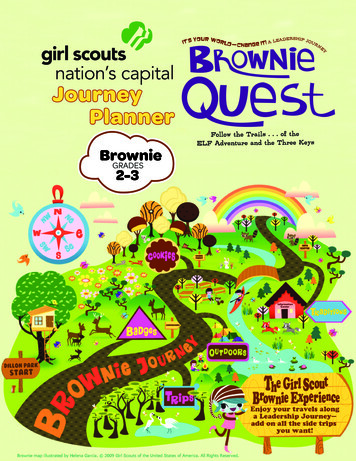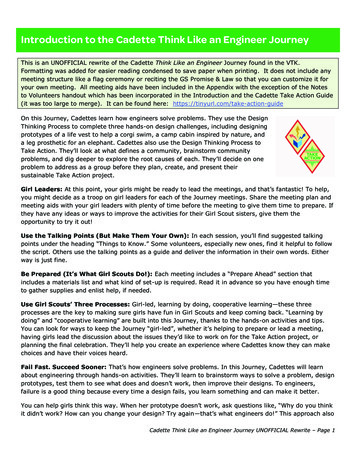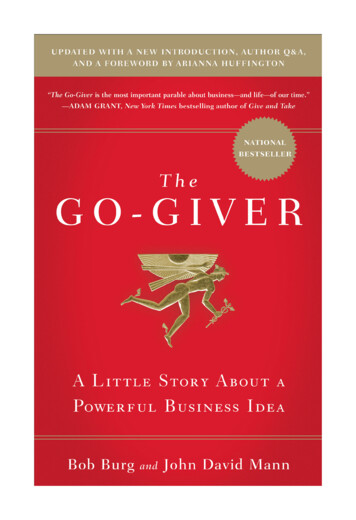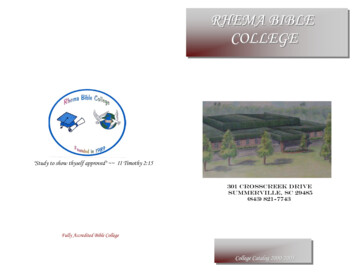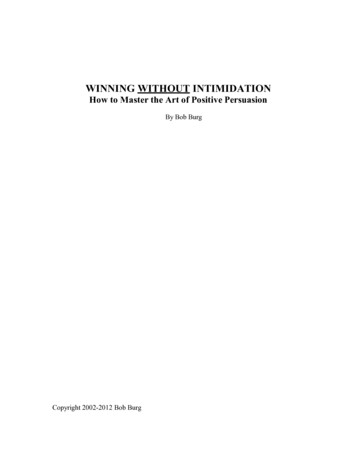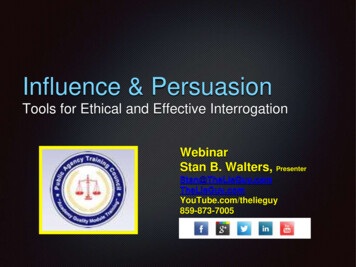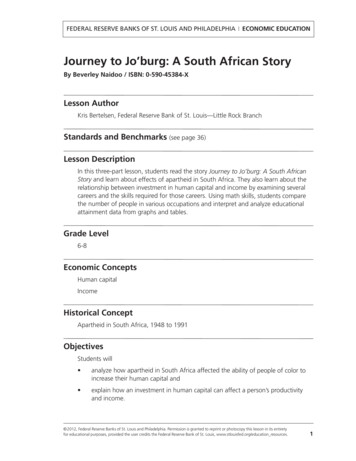
Transcription
FEDERAL RESERVE BANKS OF ST. LOUIS AND PHILADELPHIAECONOMIC EDUCATIONJourney to Jo’burg: A South African StoryBy Beverley Naidoo / ISBN: 0-590-45384-XLesson AuthorKris Bertelsen, Federal Reserve Bank of St. Louis—Little Rock BranchStandards and Benchmarks (see page 36)Lesson DescriptionIn this three-part lesson, students read the story Journey to Jo’burg: A South AfricanStory and learn about effects of apartheid in South Africa. They also learn about therelationship between investment in human capital and income by examining severalcareers and the skills required for those careers. Using math skills, students comparethe number of people in various occupations and interpret and analyze educationalattainment data from graphs and tables.Grade Level6-8Economic ConceptsHuman capitalIncomeHistorical ConceptApartheid in South Africa, 1948 to 1991ObjectivesStudents will analyze how apartheid in South Africa affected the ability of people of color toincrease their human capital and explain how an investment in human capital can affect a person’s productivityand income. 2012, Federal Reserve Banks of St. Louis and Philadelphia. Permission is granted to reprint or photocopy this lesson in its entiretyfor educational purposes, provided the user credits the Federal Reserve Bank of St. Louis, www.stlouisfed.org/education resources.1
Lesson PlanJourney to Jo’burg: A South African StoryTime Required120 minutesMaterials A copy of Journey to Jo’burg: A South African Story by Beverley Naidoo(ISBN: 0-590-45384-X) A copy of Handout 1 for each student A copy of Handout 2 for each student, pair, or small group Copies of Handout 3 cut into pairs of game cards so each student has one cardof a pair A copy of Handout 4 for each student A classroom set of calculators A copy of the Handout 4—Answer Key for the teacher A copy of Handout 5 for each student A copy of the Handout 5—Answer Key for the teacher Visuals 1, 2, 3, 4, 5, 6 Several 6-sided dice Optional: Small prizes or pieces of candy for those who are successful in theoccupation matching game.ProcedureDay 11.Begin by asking the following questions: What is a career you’d like to have when you grow up? (Answers will vary.) What education do you think is required for that career? (Answers will vary butwill range from no schooling to advanced degrees.) Why are you interested in that career? (Answers will vary.)2.Display Visual 1: Income. Define income as the payment people receive for providingresources in the marketplace. Although people can provide natural, human, andcapital resources, such as machines and tools, to earn income, most people providehuman resources—that is, labor.3.Ask students how much income they think they would earn each year in the careerthey noted. (Have a few students share. Answers will vary.) 2012, Federal Reserve Banks of St. Louis and Philadelphia. Permission is granted to reprint or photocopy this lesson in its entiretyfor educational purposes, provided the user credits the Federal Reserve Bank of St. Louis, www.stlouisfed.org/education resources.2
Lesson PlanJourney to Jo’burg: A South African Story4.Distribute to each student a copy of Handout 1: Careers to each student.5.Have students fill in the space labeled “Career in which you are really interested.” Givethem a few minutes to fill in the space labeled “Education required,” and the spacelabeled “Estimated wages.” (If students say they can’t think of a job or career, askthem to choose something based on a favorite hobby. For example, a student wholikes to play video games may want to design them one day. A student who enjoysworking with wood and building things may want to be a carpenter. Student may alsohave difficulty estimating weekly or hourly wages for the occupation they choose.Encourage them to do the best that they can and assist them as needed.)6.Discuss the following: How does school prepare you for the career you listed? (Answers will vary. Somemay say that it doesn’t. Other answers may include that school helps you learnthe following, among others: reading, writing, math, speaking, interpersonalcommunication, and technical or computer skills.) Why do you think a good education may help people get a better job and earna higher income? (Answers will vary. Point out examples of people who acquire ahigher education and earn a higher salary.) Why do you think higher levels of education generally lead to higher earnings?(Answers will vary, but lead students to the concept that the more people knowand are able to do, the more productive they should be and the more likely theywill be to earn a higher income.)7.Explain that investment in education is part of one’s human capital.8.Display Visual 2: Human Capital. Define human capital as the skills, knowledge,and personal attributes one receives from investment in education, training, andphysical health.9.Discuss a few specific jobs and the human capital each requires. (For example, teachersneed a college education, computer skills, and verbal and written communicationskills.)10. Discuss the following: How would you feel if your school taught you there were only certain jobs youcould do? (Answers will vary.) How would you feel if the government passed laws that specifically limited youraccess to education and training? (Answers will vary.) How would your life be different from what is it today if the government madeyou stay in your own town or city and wouldn’t let you leave if you didn’t have 2012, Federal Reserve Banks of St. Louis and Philadelphia. Permission is granted to reprint or photocopy this lesson in its entiretyfor educational purposes, provided the user credits the Federal Reserve Bank of St. Louis, www.stlouisfed.org/education resources.3
Lesson PlanJourney to Jo’burg: A South African Storya pass? (Answers will vary. Possible answers include limited contact with others,restricted opportunities for jobs, and feelings of imprisonment.) How would such an environment affect your ability to increase your humancapital? (Answers will vary but may include the following: You would be limitedto attending only the schools in your town, and thus would learn only what thoseschools taught. If the schools in your town were bad, you would have no otheroptions. You would have limited access to information.)11. Explain that students are going to learn about a time in South Africa’s history calledapartheid. Display Visual 3: Apartheid. Define apartheid as the system of segregationor discrimination on grounds of race in force in South Africa from 1948 to 1991.(Source: Apartheid Museum, Johannesburg, South Africa.)12. Tell students the class will be reading Journey to Jo’burg: A South African Story.Share the following synopsis:When their baby sister becomes gravely ill, 13-year-old Naledi and her 9-year-oldbrother, Tiro, make a long journey to get word to their mother, who lives and worksin Johannesburg. The children know their mother will get the medical help their sisterdesperately needs. Because of apartheid, their journey is difficult and dangerous. Alongthe way, they learn about how others fought for freedom for black South Africans.13. Explain the following: Apartheid was legal; therefore, it was easy to discriminate against people ofcolor and pay them very little for their work. It was difficult, if not impossible, for black people (native Africans) to get adequateor additional schooling needed for good, better-paying jobs. Under apartheid, schools for black children were designed to teach minimal skillsso that black people remained uneducated and submissive to whites. School teachers and society conditioned and educated black children to acceptthat they would select from a limited set of jobs available to blacks duringapartheid. The majority of these jobs required minimal skills and paid low wages.14. Explain that because you want your students to understand apartheid more fully, theywill each be assigned one of six typical jobs available to black people during apartheid.Refer students once again to Handout 1. Ask students to roll a die to receive their jobassignment: The number each student rolls will determine his/her job from the numberedlist on the handout.15. Point out the box labeled “Wage with discrimination vs. Wage without discrimination”and that the students’ apartheid wage is the first wage, listed as “Yours.” “Others”indicates how much those who didn’t face discrimination would earn. Explain that, in 2012, Federal Reserve Banks of St. Louis and Philadelphia. Permission is granted to reprint or photocopy this lesson in its entiretyfor educational purposes, provided the user credits the Federal Reserve Bank of St. Louis, www.stlouisfed.org/education resources.4
Lesson PlanJourney to Jo’burg: A South African Storymost cases, people who didn’t face discrimination (whites) earned much more incomethan those who were discriminated against (blacks and other people of color).16. Instruct students to read to themselves their assigned job description and imagine thiswill be their job for their entire adult life. (Students may respond negatively about thejob descriptions and low pay; remind them that, under apartheid, black people hadlimited options to correct this unfairness.)17. Establish a timeline for the lesson: Point out that after they have read the story (in twodays or so) you will come back to discuss the careers students were assigned, but forthe time being, they are going to imagine what it may have been like to live underthe system of apartheid. Tell students to keep their copy of Handout 1 (or collect asdesired) because they will use it again after reading the story.18. Read the story as a class or assign as individual reading.Day 219. After reading the story, use the following questions to guide discussion: Why did Naledi and Tiro decide to walk to Jo’burg? (Their little sister, Dineo, wasgravely ill at home and their mother lived and worked in Jo’burg. The childrenbelieved that if they could tell their mother about Dineo, she would come homeand get her the medical care she needed. Because they had no money, thechildren’s only option was to walk to Jo’burg.) Why were the children so afraid of the police? (The children knew that policemencould stop blacks and ask for a pass at any time. Even though the children werenot required to have a pass, they were afraid because they knew the police wereoften violent toward blacks.) In what instances did people need a pass to move around in South Africa?(“If you wanted to visit some place, the pass must allow it. If you wanted tochange jobs, the pass must allow it.” [page 8]) How do you think requiring people to have a pass affected their ability to improvetheir education and occupation? (Answers will vary. If you weren’t allowed in anarea with the type of school you wanted to attend, you wouldn’t be able to getthe training for the job you wanted, even if you had the needed skills or ability.)Note to Teacher: Explain the following (if desired): The Natives (Abolition ofPasses and Co-ordination of Documents) Act, Act No 67 of 1952, commonlyknown as the Pass Laws, forced black men to carry identification with them at alltimes. This identification, commonly called a pass, included a person’s photograph,address, employment record, tax payments, fingerprints, and police record. It was acriminal offense to be caught without a pass in white areas, which were generally 2012, Federal Reserve Banks of St. Louis and Philadelphia. Permission is granted to reprint or photocopy this lesson in its entiretyfor educational purposes, provided the user credits the Federal Reserve Bank of St. Louis, www.stlouisfed.org/education resources.5
Lesson PlanJourney to Jo’burg: A South African Storydeveloped urban areas. Black people could go to designated white areas only if theyhad permission, which was recorded in the pass. Laws determined how long blackpeople could stay in a white area. Permission to seek work was also recorded in thepass. Initially, only men were required to carry a pass. In 1956 the law changed andwomen were required to carry one also. Pass laws were not repealed until 1986. Why did Naledi and Tiro’s mother work so far from home? (Apartheid dictatedwhere blacks could live, and the children’s family was not allowed to live in thearea of Johannesburg where their mother worked; the children’s mother had toearn money to send her children to school.) When Naledi and Tiro asked their mother why they couldn’t live in the city withher, what reason did she give? (“The white people who make the laws don’tallow it. That’s how it is.” [page 20]) Why did the children’s mother tell them to work hard in school? (Answers willvary but could include the value she saw for their future, increased income, andbetter opportunities.) When the children met Grace, she explained that the children must look forbuses that say “nonwhites only.” When the children said they were sorry fortrying to get on a white bus, Grace said, “They should be sorry, those stupidpeople! Why shouldn’t we use any bus? When our buses are full, their busesare half empty. Don’t you be sorry!” [page 26] Why do you think Grace felt thisway? (After years of unequal treatment and unfair conditions, people of colorknew what they were missing out on in terms of education, opportunities, etc.) Were children required to have a pass to travel in Jo’burg? (No, not until theywere 16.) Grace described 1976 as the “Time of Fire.” What happened? (Many students inthe city of Soweto, including her brother Dumi, protested because the whitegovernment was not providing a good education for black students, who werelearning only what the whites wanted them to know. [Note: This was called theSoweto Uprising.]) What happened to Grace’s brother Dumi as a result of his involvement duringthe “Time of Fire”? (He was arrested for his involvement in the protest. He was putin prison and badly beaten. After he was released, he disappeared and had nocontact with his family. A year later, his family received a letter saying he wasstudying in another country but would return one day to fight for freedom.) Naledi’s mother told her about the children in Soweto who wanted to learn morethan how to be servants. Why do you think schools were limiting the educationblack students received? (Answers will vary but should include that the apartheidgovernment didn’t want blacks to participate fully in society or increase theirhuman capital.) When Naledi and her mother were at the hospital with Dineo, how do you thinkNaledi felt when the baby died while the mother was waiting to see the doctor? 2012, Federal Reserve Banks of St. Louis and Philadelphia. Permission is granted to reprint or photocopy this lesson in its entiretyfor educational purposes, provided the user credits the Federal Reserve Bank of St. Louis, www.stlouisfed.org/education resources.6
Lesson PlanJourney to Jo’burg: A South African Story(Answers will vary but may include the following: Naledi likely feared Dineo woulddie. She likely felt sympathy for the young mother because she referred to howthe mother’s sobbing pierced her mind.) When Mma came out of the hospital, Naledi asked her what the doctor saidabout Dineo. What did the doctor say the child needed to keep her body strong?(The doctor said that she needed milk, fruit, and vegetables.) What did Mma say the doctor didn’t tell her? (Mma said he didn’t tell her howto get the money to pay for them.) How does a healthy diet help one’s human capital? (Answers will vary. Goodphysical health allows one to be a better student and worker.) When the children returned from Jo’burg, Naledi began to think deeply aboutall she had learned. She started thinking about her future and her education.The book says,It was her school too. All those lessons on writing letters for jobs asservants always writing how good they were at cooking, cleaning,washing, gardening always ending with “Yours obediently.”Naledi had never thought about it before tonight, but never, never,had she written about wanting to be say, a doctor. Yes, that’s whatshe’d like to be. (page 72)Do you think it would be easy or difficult for Naledi to reach her dream underapartheid? (Under apartheid, it would be very difficult for her.) What would have been required for Naledi to become a doctor? (Answers willvary. Point out that the educational system in South Africa would have neededto be changed to allow black students access to educational opportunities. Nalediwould also have needed to acquire a high level of training, education, and practice[residency] to become a doctor—that is, a great deal of investment in her humancapital.)20. Distribute Handout 2: South African Apartheid Timeline and allow time for students tocomplete in class.21. Review and discuss the answers using the Handout 2: South African ApartheidTimeline—Answer Key.Day 322. How did changes in South Africa—starting with the end of apartheid—open upopportunities for people like Naledi to invest in their human capital? (Answers will vary.Possible answers should include increased educational opportunities, better healthcare, and more political participation.) 2012, Federal Reserve Banks of St. Louis and Philadelphia. Permission is granted to reprint or photocopy this lesson in its entiretyfor educational purposes, provided the user credits the Federal Reserve Bank of St. Louis, www.stlouisfed.org/education resources.7
Lesson PlanJourney to Jo’burg: A South African Story23. Ask students to take out Handout 1 (or redistribute if collected). Ask a studentvolunteer from each assigned job to read the job description to the class. Discuss thefollowing: What are your thoughts about the career, including its pay and conditions, youwere assigned in the first lesson? (Answers will vary.) What are some reasons that the job you were assigned under apartheid paid solittle income? (Apartheid made it legal to discriminate and pay black workers lessthan white workers. People of color were denied access to education and opportunities to increase their human capital. The difficulty of travel in the country—due to passes—limited people’s opportunities as well.) How could people feel obligated, or even forced, to work such long hours indangerous conditions? (There were few opportunities for people of color; theywere forced, economically, to take whatever job they could get.) If you were given a chance to change the job you were assigned, would you?Why? What would it take to do that? (Answers will vary, but most students wouldwant to take advantage of this opportunity for a variety of reasons. They maysuggest that they would have to move, get more education, etc.)24. Remind students that Naledi’s dream was to be a doctor and that you began thislesson by asking them to consider a career they would like to have some day. Explainthat they are now going to play a matching game to help them learn about somedifferent careers, the education required, and approximate pay.25. Give each student a card from Handout 3: Occupation Matching Game, making surethat pairs of cards are used. If you have an odd number of students, two students mayshare one card. (Note: Although students don’t need to be told yet, matching cardshave the same symbol, for example, and or and . If students ask what thesymbols means, tell them you will explain later.)26. Explain that there are 16 pairs of occupation cards in the room (assuming a completeset is used) and that each student has a card that is either (1) a description of an occupation with the education required or (2) a specific occupation and its median earningsper year or hourly wage. Tell students their task is to move around the room and locatethe person with the card that matches their own. They will have to read the cards andmake guesses about education and earnings.27. Tell students to circulate, find their match, and sit down with the person holding thematching card. Allow students 5 minutes or so for matching. (Note: You may offer asmall prize to those who make a correct match.)28. Once students are finished and seated, display Visual 4: Occupation Matching Game—Answers and have them check to see if they are correctly matched by looking at thesymbols listed on their cards. Allow them to move if they are not correct. 2012, Federal Reserve Banks of St. Louis and Philadelphia. Permission is granted to reprint or photocopy this lesson in its entiretyfor educational purposes, provided the user credits the Federal Reserve Bank of St. Louis, www.stlouisfed.org/education resources.8
Lesson PlanJourney to Jo’burg: A South African Story29. Were you surprised by the educational requirements or pay for any of the occupations?(Answers will vary).30. Ask students to refer again to Handout 1 and look at the career they chose.31. Ask a few students if they are willing to share their career ideas. Have them writetheir career choices on the board. Discuss the following: Why did you choose your noted occupation? (Answers will vary but may includethat they have special skills, are interested in the job, think it pays well, wouldenjoy the hours, or would like the work environment.)Note to the Teacher: Many middle and high school students dream of joining theprofessional sports ranks, but few understand how difficult and improbable that is.In the next part of the lesson, students use math to compare various occupationsstarting with professional athletes, followed by physicians, teachers, and administrativeassistants. What human capital is required to become a professional athlete? (Answers willvary but should include physical ability, intense practice and training, study ofstrategy, and knowledge of the game rules.) Why do you think the salaries of professional athletes are so high? (Answers willvary and may include product endorsements and high performance.)32. Point out that professional athletes have specialized human capital and few peoplehave that same level of unique human capital. This reason, combined with highconsumer demand for sports entertainment, drives up the pay of these athletes.33. Display row 1 of Visual 5: Estimated Probability of Competing in Athletics Beyond theHigh School Interscholastic Level. (Note: Data in Visual 5 are from the following chartfrom the National Collegiate Athletic Association [NCAA], accessed November 9, es/Recruiting/Probability of Going Pro.)34. Ask students the following questions and reveal each answer after they make theirpredictions: How many high school athletes from each sport do you think move on to compete at the college (NCAA) level? (Answers will vary. The correct answers are inrow 2 of Visual 5.) How many of these college (NCAA) student-athletes do you think are draftedby professional teams? (Answers will vary. The correct answers are in row 3 ofVisual 5.) 2012, Federal Reserve Banks of St. Louis and Philadelphia. Permission is granted to reprint or photocopy this lesson in its entiretyfor educational purposes, provided the user credits the Federal Reserve Bank of St. Louis, www.stlouisfed.org/education resources.9
Lesson Plan Journey to Jo’burg: A South African StoryWhat percentage of high school student-athletes eventually become professionalathletes? (Answers will vary. The correct answers are in row 4 of Visual 5.)35. Display Visual 4 again and discuss the following, referring back to the occupationmatching game cards: What level of education is required to become a fast-food worker? (There areno specific educational requirements, but some employers prefer high schoolgraduates.) What is the median wage of a fast-food worker? ( 8.00 per hour) What level of education is required to become a plumber? (Most receive trainingfrom technical colleges or apprenticeship programs.) What is the median wage of a plumber? ( 15.72 per hour) What level of education is required to become a college professor? (A doctoraldegree [PhD] is usually required. However, professors may have a master’s degreeonly or be a doctoral candidate for certain disciplines or some part-time andtemporary jobs). What is the median income of a college professor? ( 58,830 per year) If a college professor works 40 hours per week and an average of 44 weeks peryear, how much is the mean hourly wage of a college professor? ( 58,803/44 1,337 per week; 1337/40 hours 33.43 per hour) In general, what do you observe about the amount of income a person earnsas his or her level of education increases? (As education increases, incomeincreases.) How many of you know someone who has worked or works in a restaurant?(Answers will vary, but many students will know someone. Many of the positionsare filled by young people.) Why do you suppose chefs earn more income than support staff at restaurants?(Many chefs go to culinary arts schools to learn to cook and have a higher levelof education and training.) According to the game card, what are different ways someone can learn to be aplumber? (You can become a plumper through an apprenticeship or by attendinga technical school or community college.) How many of you personally know a major-league, professional athlete? (Somestudents may know one, but it is highly unlikely.) Both dishwashers and athletes do physical jobs. So, why isn’t it as easy to becomea professional athlete as it is to become a dishwasher? (You need the properhuman capital to become a professional athlete: Athletes are highly specialized intheir training and education about their sport. Dishwashers do not need this levelof human capital.) 2012, Federal Reserve Banks of St. Louis and Philadelphia. Permission is granted to reprint or photocopy this lesson in its entiretyfor educational purposes, provided the user credits the Federal Reserve Bank of St. Louis, www.stlouisfed.org/education resources.10
Lesson Plan Journey to Jo’burg: A South African StoryWhat is the main reason there are so few professional athletes? (So few peoplehave the combination of athletic ability, talent, practice, opportunity, and overallhuman capital to become a professional athlete.)36. Display Visual 6: Years of Education and Weekly Median Income and ask the following: What happens to income as more education is attained? (More income is earned). Of the levels of education listed on the graph, who earns the least weekly income?(High school dropouts earn 444 per week.) At which level of education is weekly income the highest? (Professional degree: 1,610 per week) What are some examples of professions that require a professional degree?(Answers will vary but may include attorneys, veterinarians, and medical doctors). Is the mathematical relationship between income and education negative orpositive? (Positive)37. Explain to students that they will use their math skills to see how many people workin various occupations. Distribute a copy of Handout 4: Human Capital and Math anda calculator to each student. Complete the first problem as a class, then have studentswork with their partner from the matching game to complete the rest of the work.(Note: There may be some variance in calculations due to rounding.)38. Use a copy of Handout 4: Human Capital and Math—Answer Key to review theanswers with the class.Closure39. Review the important content of the lesson by asking the following questions: What is apartheid? (Apartheid is the system of segregation or discrimination ongrounds of race in force in South Africa from 1948 to 1991.) How did apartheid affect human capital development for black South Africans?(Schools conditioned blacks to accept white domination, and blacks were notallowed the same educational opportunities or resources as whites. Laws prevented blacks from traveling without passes and kept them in low-paying menialjobs.) What is human capital? (Human capital is the skills, knowledge, and personalattributes one receives from investment in education, training, and physicalhealth.) What are the skills, education, and other human capital investments you willneed to achieve your goal of attaining the career you listed in the opening activityof this lesson? (Answers will vary depending on the occupation chosen.) 2012, Federal Reserve Banks of St. Louis and Philadelphia. Permission is granted to reprint or photocopy this lesson in its entiretyfor educational purposes, provided the user credits the Federal Reserve Bank of St. Louis, www.stlouisfed.org/education resources.11
Lesson PlanJourney to Jo’burg: A South African Story What is income? (Income is the payment people receive for providing resourcesin the marketplace. Although people can provide natural, human, and capitalresources, such as machines and tools, to earn income, most people providehuman resources—that is, labor.) What usually happens to the amount of income earned as one’s level of education increases? (As education increases, income increases.) Why? (People who arehighly educated and skilled are generally more productive than those who are not.) What usually happens to the total number of people in a given career as therequired level of education (human capital) increases? (The total numberdecreases because there are fewer people who are highly skilled and productive.)Assessment40. Give each student a copy of Handout 5—Assessment. Go over the directions andanswer any questions. 2012, Federal Reserve Banks of St. Louis and Philadelphia. Permission is granted to reprint or photocopy this lesson in its entiretyfor educational purposes, provided the user credits the Federal Reserve Bank of St. Louis, www.stlouisfed.org/education resources.12
Lesson PlanJourney to Jo’burg: A South African StoryVisual 1: IncomeIncomeThe payment people receivefor providing resources in themarketplace. Although peoplecan provide natural, human,and capital resources, such asmachines and tools, to earnincome, most people providehuman resources—that is, labor. 2012, Federal Reserve Banks of St. Louis and Philadelphia. Permiss
The children know their mother will get the medical help their sister desperately needs. Because of apartheid, their journey is difficult and dangerous.Along the way, they learn about how others fought for freedom for black South Africans. 13. Explain the following: Apartheid was legal; therefore, it was easy to discriminate against people of
